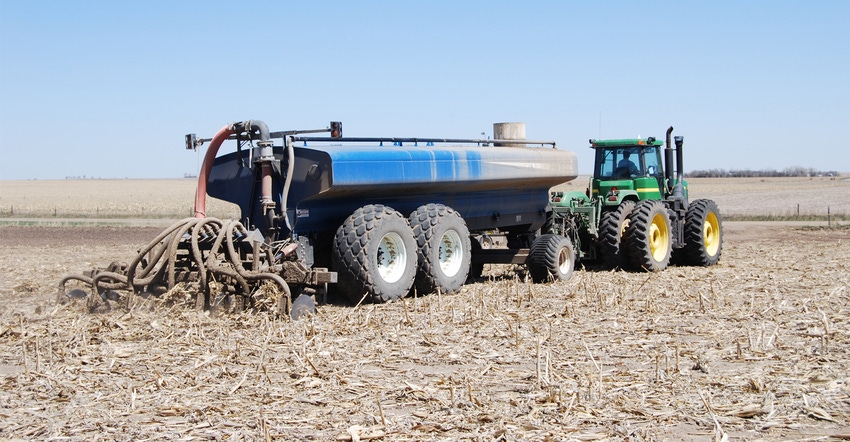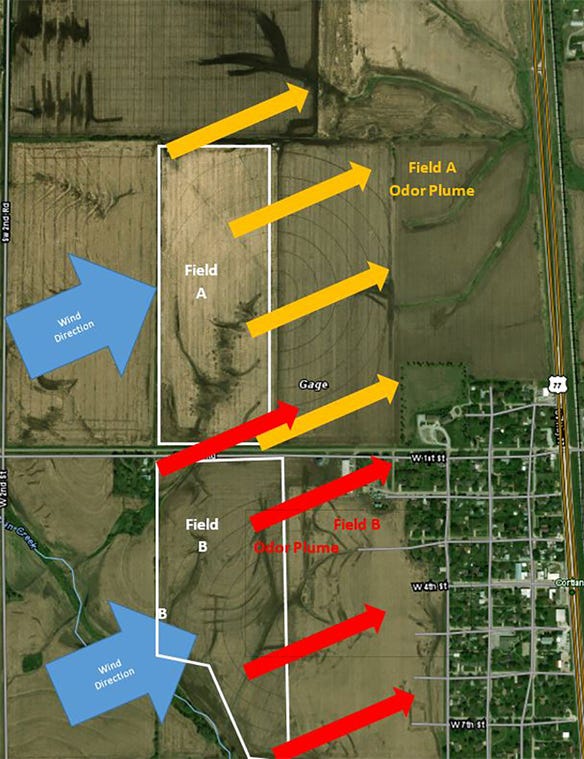August 28, 2018

By Rick Koelsch
Roughly half of all neighbor complaints of livestock odors originate from land application of manure. Weather forecasts and a little knowledge of odor dilution can be powerful tools for keeping your neighbors happy — or at least avoiding irate phone calls.
Incorporation of manure into the soil is always the “best” practice for controlling odor. Soil is an excellent filter for removing odors released by manure. However, maintaining residue cover to protect soil quality, reduce erosion and conserve water doesn't always allow for manure to be incorporated.
When manure can't be incorporated, the next 36-hour period after land-applying manure is the most critical. Why? Good drying conditions over the next two days can significantly reduce the release of odors. Meanwhile, the next two evenings are the most likely time when neighbors will experience odors. Especially when applying manure without incorporating it, pay close attention to the forecast for the 36 hours after application.
Predicted wind direction
Wind direction is the single most critical information for selecting fields for land application of manure. Odor plumes travel in the same direction as wind and spread out laterally very little. By identifying the edges of the field perpendicular to the wind and the wind’s direction, you can quickly identify the neighbors at greatest risk and those unlikely to be impacted.

KEY PREDICTOR: Wind direction is an important predictor for identifying which neighbors are at risk.

In the two land application site options illustrated in the diagram (Fields A and B), Field A presents a much smaller risk to nearby neighbors than does Field B. By choosing a land application site a half mile to the north for this southwest wind, the risk has been dramatically reduced. By paying attention to the wind directional forecast for a 36-hour period after applying manure, applicators can gauge the risk of odor affecting neighbors.
Evening hours and application
Can you recall a time when you observed a smoke cloud hanging near the ground? Often this is observed when air temperatures are cooling, and winds are light, most commonly during evening and nighttime hours. Under these conditions the smoke is not being diluted and is being held near the ground. Although we can't see odors, the same atmospheric conditions create the greatest risk for neighbors experiencing odors.
Under daytime conditions, odor plumes are generally rising and diluted with fresh air to the point they are unlikely to be noticed by your neighbors. Bright sunshine and warming air are best for dispersing odors. Higher wind speeds (especially at night) also encourage greater mixing of fresh and odorous air, and reduce odor risk. Be mindful that nighttime hours with low wind speeds are the conditions most likely to expose neighbors to odors from land application.
Weather forecasts and odors
Weather forecasts that provide wind direction and speed, sky conditions, and temperature can be extremely valuable in deciding when and where to apply manure. Many weather services provide this information in their forecasts.
Aviation Weather Report and Forecast shares the important forecast information in an easily reviewed visual format. For example, a Columbus, Neb., forecast from July 19-20 showed nighttime conditions would produce higher risks for neighbors in the immediate future. No extended periods of good drying conditions are available before the high-risk night conditions occur.
So, if waiting for more desirable weather conditions is not a choice, what is your next best option?
Note the forecast nighttime wind direction and use this information to select a land application site with the fewest downwind residences.
Picking the right weather conditions for land-applying manure may not improve your popularity in the community, but it can go a long way with improving your community’s acceptance of livestock systems.
Koelsch is a Nebraska Extension livestock environmental engineer. This report comes from UNL CropWatch.
You May Also Like




